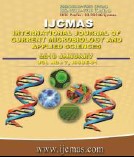


 National Academy of Agricultural Sciences (NAAS)
National Academy of Agricultural Sciences (NAAS)

|
PRINT ISSN : 2319-7692
Online ISSN : 2319-7706 Issues : 12 per year Publisher : Excellent Publishers Email : editorijcmas@gmail.com / submit@ijcmas.com Editor-in-chief: Dr.M.Prakash Index Copernicus ICV 2018: 95.39 NAAS RATING 2020: 5.38 |
The water is an essential component of human life and survival of plants and animals. Estimation of evaporation is very important in arid and semi-arid region where the shortage of water occurs. It plays an important role for planning and management of water resources projects, necessary for scheduling of irrigation and in planning farm irrigation systems. It is a very important component of hydrologic cycle and water resources problems. In the present study the Artificial Neural Network (ANN) and Co-Active Neuro Fuzzy Inference System (CANFIS) models were developed for estimating evaporation. The data set consisted of four years of daily records from 2010 to 2013. The daily data consist of temperature, relative humidity, wind speed, sunshine hour and evaporation. The daily data of temperature, relative humidity, wind speed, sunshine hour were used as input and the evaporation was used as the output. For estimation of evaporation 70% data was used for training and 30% for testing of models. ANN and CANFIS were used for designing of models based on activation function; Tanh Axon and learning rule; Levenberg Marquardt with 1000 number of epochs, two hidden layers with 2, 3...8 neuron in each hidden layers. Gaussian membership function was used in CANFIS. The performance of ANN and CANFIS models was compared on the basis of statistical functions such as RMSE, R2, and CE. The results indicate that the ANN performed superior to the CANFIS. It was concluded that the ANN model can be successfully employed for the estimate on of daily evaporation at Hawalbagh, Almora.
 |
 |
 |
 |
 |